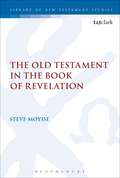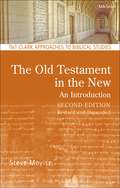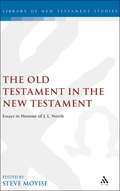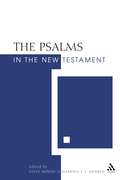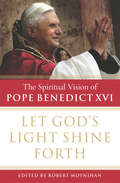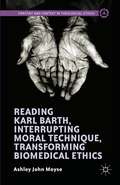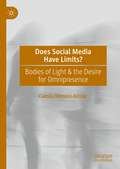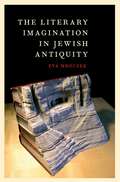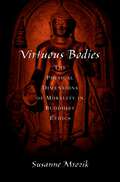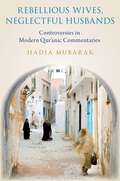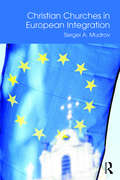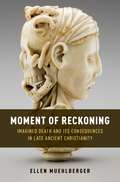- Table View
- List View
Evoking Scripture: Seeing the Old Testament in the New
by Steve MoyiseIn clear and lucid prose Evoking Scripture explores the literary and theological frameworks that lie behind the various quotations from and allusions to the Old Testament in the New. Steve Moyise takes a series of case studies from Mark, Romans, Galatians, 1 Peter and Revelation to raise key questions about the author's hermeneutical stance as well as the methods and assumptions of those who study them. Engaging in debate with scholars such as Christopher Stanley, Richard Hays and Francis Watson, Evoking Scripture draws on the insights of both author-centered and reader-centered approaches, while also offering a critique of them. Each chapter focuses on a particular question. For example, is the opening quotation of Mark's Gospel intended to evoke a prophetic framework for understanding the rest of the book? Does Paul quote Habakkuk in order to evoke its 'theodicy' theme or as a summary of 'righteousness by faith'? Does the prophecy theory of 1 Peter 1:10-12 ('the prophets who prophesied of the grace that was to be made yours made careful search...') explain the author's actual uses of Scripture? The results are brought together in a final chapter which explores the literary and theological frameworks of the New Testament authors and of the scholars who study them.
Introduction to Biblical Studies (T&T Clark Approaches to Biblical Studies)
by Steve MoyiseThis is an ideal introduction to modern biblical studies. Readers are introduced to questions of inspiration, canon and authority. This is followed by chapters on historical approaches to the Bible, such as source, form and redaction criticism. Comparisons with other literature, such as ancient flood stories or Egyptian psalms help to set the context for this. Moyise also asks such questions as 'How did we get the Bible?' and, 'why do modern versions of the Bible differ among themselves?' Moyise considers a number of approaches to the Bible. Beginning with literary criticism, he shows how texts 'speak' to readers and influence their attitudes, emotions and behaviour. This is followed by liberation, feminist and finally a variety of theological approaches used by those who consider the Bible to be sacred scripture. For the third edition Moyise has added two sections, one giving a basic outline of the biblical story together with a timeline and key dates, and another on dating the New Testament.
Introduction to Biblical Studies: An Introduction (T&T Clark Approaches to Biblical Studies)
by Steve MoyiseThis is an ideal introduction to modern biblical studies. Readers are introduced to questions of inspiration, canon and authority. This is followed by chapters on historical approaches to the Bible, such as source, form and redaction criticism. Comparisons with other literature, such as ancient flood stories or Egyptian psalms help to set the context for this. Moyise also asks such questions as 'How did we get the Bible?' and, 'why do modern versions of the Bible differ among themselves?' Moyise considers a number of approaches to the Bible. Beginning with literary criticism, he shows how texts 'speak' to readers and influence their attitudes, emotions and behaviour. This is followed by liberation, feminist and finally a variety of theological approaches used by those who consider the Bible to be sacred scripture. For the third edition Moyise has added two sections, one giving a basic outline of the biblical story together with a timeline and key dates, and another on dating the New Testament.
The Old Testament in the Book of Revelation (The Library of New Testament Studies #115)
by Steve MoyiseThis book explores the relationship between the new context that John provides for his allusions and their context in the Old Testament. For example, did John choose texts to meet the needs of the recipients or did his meditation on the scriptures give him a unique insight into their situation? Ramsay held that local knowledge led to John's choice of texts whereas Beale believed that Revelation is a midrash on Daniel. Both are one-sided, as a study of John's use of Ezekiel shows. John based a number of his incidents on Ezekiel, in much the same order. Nevertheless, there are also major discontinuities, such as his denial of the very thing-the temple-that Ezekiel 40-48 is all about. To do justice to John's use of the Old Testament requires an interactive model, which involves the use of scripture at Qumran and the concept of intertextuality. Moyise shows John to be a master of combining and juxtaposing images.
The Old Testament in the New: Second Edition: Revised and Expanded (T&T Clark Approaches to Biblical Studies)
by Steve MoyiseSteve Moyise provides an accessible and well-informed introduction to the Old Testament in the New Testament. Tried and tested in previous editions, it explores the basic issues and offers summaries of the uses of the Old Testament in the Gospels and Acts, in Paul and Hebrews, James, and Revelation. Issues of quotation, allusion and echo are fully explored and placed sensitively in the context of the differing approaches to the interpretation of Old Testament texts. Readers are informed of contemporary debates that have arisen from literary criticism, such as the questions of intertextuality and the uses of allegory. Also discussed are the uses of the Bible in the first century. For the second edition two entirely new chapters on 'Jesus and Scripture' and 'James and 1-3 John' have been added, as well as full revisions to the text where necessary to take account of changes and developments in scholarship. Each chapter includes a summary-conclusion, and extensive and detailed suggestions for further reading. This is an ideal textbook for undergraduate students.
The Old Testament in the New: Second Edition: Revised and Expanded (T&T Clark Approaches to Biblical Studies)
by Steve MoyiseSteve Moyise provides an accessible and well-informed introduction to the Old Testament in the New Testament. Tried and tested in previous editions, it explores the basic issues and offers summaries of the uses of the Old Testament in the Gospels and Acts, in Paul and Hebrews, James, and Revelation. Issues of quotation, allusion and echo are fully explored and placed sensitively in the context of the differing approaches to the interpretation of Old Testament texts. Readers are informed of contemporary debates that have arisen from literary criticism, such as the questions of intertextuality and the uses of allegory. Also discussed are the uses of the Bible in the first century. For the second edition two entirely new chapters on 'Jesus and Scripture' and 'James and 1-3 John' have been added, as well as full revisions to the text where necessary to take account of changes and developments in scholarship. Each chapter includes a summary-conclusion, and extensive and detailed suggestions for further reading. This is an ideal textbook for undergraduate students.
The Old Testament in the New Testament: Essays in Honour of J.L. North (The Library of New Testament Studies #189)
by Steve MoyiseThis collection of papers from members of the 'Use of the Old Testament in the New Testament' seminar (held at St Deinid's, Hawarden, Wales) has been commissioned to honour its retiring chairperson, J.L. North. It includes contributions by Michael Goulder (Isaiah 61), Joel Marcus (Matthew), Maurice Casey (Christology), George Brooke (Parables), Judith Lieu (John), Peter Doble (Acts), Morna Hooker (Philippians), John O'Neill (Galatians), Ivor Jones (2 Thessalonians), Martin Menken (Matthew) and Steve Moyise (Intertextuality). BLURB AS REWRITTEN BY PRD 11 JANUARY 2000: It is well known, but not always appreciated that the 'Bible' of the earliest Christians was the Old Testament. How did the New Testament writers justify their faith in the risen Messiah from these Jewish scriptures? In this book, distinguished biblical scholars supply answers to these questions, both in general terms and from specific examples. Under review come individual New Testament writers (Matthew, Paul, John) and important themes (the Anointed One, monogamy and divorce), while crucial passages such as John 11, Isaiah 66 and Revelation 12 are put under the microscope. This collection demonstrates the ingenuity and vitality of early Christian scriptural exegesis, and offers the reader an up to date picture of the most recent research in one of the central issues of New Testament literary and theological study.
Deuteronomy in the New Testament: The New Testament and the Scriptures of Israel (The Library of New Testament Studies #358)
by Steve Moyise Maarten J.J. MenkenDeuteronomy in the New Testament brings together a set of specially commissioned studies by authors who are experts in the field. After an introductory chapter on the use of Deuteronomy in the second temple literature, each of the New Testament books that contain quotations from Deuteronomy are discussed: Matthew, Mark, Luke-Acts, John, Romans & Galatians, 1 & 2 Corinthians, Hebrews, the Pastoral Epistles and Revelation. The book provides an overview of the status, role and function of Deuteronomy in the first century. It considers the Greek and Hebrew manuscript traditions and offers insights into the various hermeneutical stances of the New Testament authors and the development of New Testament theology.
Isaiah in the New Testament: The New Testament and the Scriptures of Israel
by Steve Moyise Maarten J.J. MenkenIsaiah in the New Testament brings together a set of specially commissioned studies by authors who are experts in their field. Beginning with an introductory chapter on the use of Isaiah in the Dead Sea Scrolls and Second Temple literature, contributors go on to discuss each of the New Testament books that contain quotations from Isaiah: Matthew, Mark, (Q), Luke-Acts, John, Romans and Galatians, 1 and 2 Corinthians, Hebrews, 1 Peter and Revelation. Together they provide an overview of the status, role and function of Isaiah in the first century, considering the Greek and Hebrew manuscript traditions and offering insights into the various hermeneutical stances of the New Testament authors and the development of New Testament theology. The volume includes contributions from Darrell Hannah, Morna Hooker, Christopher Tuckett, Richard Beaton, Bart Koet, Catrin Williams, J. Ross Wagner, Florian Wilk, Cecil McCullough, Steve Moyise and David Mathewson.
The Psalms in the New Testament
by Steve Moyise Maarten J.J. MenkenThis book offers a comprehensive summary of the use of the Psalms at Qumran and in the New Testament. For the first time this collection offers a set of studies which will offer an overview of the role and function of the Psalms in the first century. Each chapter considers matters of textual form, points of particular interest, and hermeneutics. Together, this collection forms an important research tool for Septuagintal and manuscript studies, first-century hermeneutics and the development of Christian apologetics and theology. The contributors have all either written or are writing monographs on their particular section of the New Testament/ Qumran. In a number of cases, the particular chapter will be the first of its kind (such as Steve Moyise's discussion of Psalms in Revelation).
Let God's Light Shine Forth: The Spiritual Vision of Pope Benedict XVI
by Robert MoynihanPublished at the beginning of Pope Benedict XVI's papacy in 2005, Let God's Light Shine Forth, introduced the world to his spiritual vision of hope. The election of Cardinal Joseph Ratzinger as successor to Pope John Paul II aroused tremendous interest not only among Catholics but throughout the world. Formerly the head of the Congregation for the Doctrine of Faith and known for his stand against liberation theology and social activism on issues such as homosexuality, in his first days as Pope demonstrated a pastoral and very human face to the world. His deep faith, his theological learning and his intellectual gifts are without peer, and provided the foundation for his Papacy until his abdication in 2013,This book, from the editor of Inside the Vatican, explores Benedict's beliefs and policies through his own writings. Robert Moynihan sets the scene for his momentous election and then surveys his writings: on Jesus, Mary and the Sacrements, on the wider issues of faith and spirituality, and on the world today. In conclusion he reveals Benedict XVI's views expressed since his election and shows how these relate to his spiritual vision for the Church and the world.
Pray For Me: The Life and Spiritual Vision of Pope Francis
by Robert MoynihanBenedict XVI's retirement made news around the world, and changed the dynamics of the Catholic Church. The new pope, Francis I, has already brought a breath of fresh air into the papacy, the Vatican and the faith which has been beset by scandal in recent times. His humility, his charm, his concern for the poor, have captivated the world. But who is he?Pray For Me is the perfect, short introduction to Francis' life and spiritual teachings. It will be of interest not only to committed Catholics but also to those of other faiths, and none, who follow world events and wish to be as well informed as possible.
Reading Karl Barth, Interrupting Moral Technique, Transforming Biomedical Ethics (Content and Context in Theological Ethics)
by Ashley John MoyseThis volume proposes a move away from the universalized and general modern ethical method, as it is currently practiced in biomedical ethics, while aiming toward a decision making process rooted in an ontology of relationality. Moyse uses the theological ethics of Karl Barth, in conversation with a range of thinkers, to achieve this turn.
Does Social Media Have Limits?: Bodies of Light & the Desire for Omnipresence
by Camila Mozzini-AlisterThis book is a vibrant investigation on a deeply human subconscious desire: the desire for omnipresence, or in a nutshell, the desire to be here, there, and everywhere at the same time. After all, why is it not enough just to be in the offline ordinariness of the here and now? To answer this question, Camila Mozzini-Alister does the crossing of two seemingly distant universes: mediation and meditation. Throughout a vigorous archaeology of the relationship between screen and mind allied with an engaging first-person narrative, the author raises awareness of the risks of becoming addicted to social media and obsessed by meditation. This brings forth a vital question: what are the limits for the desire to be more than a body?
The Literary Imagination in Jewish Antiquity
by Eva MroczekWinner of the 2017 Manfred Lautenschlaeger Award for Theological Promise Winner of the 2017 The George A. and Jean S. DeLong Book History Book Prize The discovery of the Dead Sea Scrolls revealed a world of early Jewish writing larger than the Bible, from multiple versions of biblical texts to "revealed" books not found in our canon. Despite this diversity, the way we read Second Temple Jewish literature remains constrained by two anachronistic categories: a theological one, "Bible," and a bibliographic one,"book." The Literary Imagination in Jewish Antiquity suggests ways of thinking about how Jews understood their own literature before these categories had emerged. In many Jewish texts, there is an awareness of a vast tradition of divine writing found in multiple locations that is only partially revealed in available scribal collections. Ancient heroes such as David are imagined not simply as scriptural authors, but as multidimensional characters who come to be known as great writers who are honored as founders of growing textual traditions. Scribes recognize the divine origin of texts such as Enoch literature and other writings revealed to ancient patriarchs, which present themselves not as derivative of the material that we now call biblical, but prior to it. Sacred writing stretches back to the dawn of time, yet new discoveries are always around the corner. Using familiar sources such as the Psalms, Ben Sira, and Jubilees, Eva Mroczek tells an unfamiliar story about sacred writing not bound in a Bible. In listening to the way ancient writers describe their own literature-rife with their own metaphors and narratives about writing-The Literary Imagination in Jewish Antiquity also argues for greater suppleness in our own scholarly imagination, no longer bound by modern canonical and bibliographic assumptions.
The Literary Imagination in Jewish Antiquity
by Eva MroczekWinner of the 2017 Manfred Lautenschlaeger Award for Theological Promise Winner of the 2017 The George A. and Jean S. DeLong Book History Book Prize The discovery of the Dead Sea Scrolls revealed a world of early Jewish writing larger than the Bible, from multiple versions of biblical texts to "revealed" books not found in our canon. Despite this diversity, the way we read Second Temple Jewish literature remains constrained by two anachronistic categories: a theological one, "Bible," and a bibliographic one,"book." The Literary Imagination in Jewish Antiquity suggests ways of thinking about how Jews understood their own literature before these categories had emerged. In many Jewish texts, there is an awareness of a vast tradition of divine writing found in multiple locations that is only partially revealed in available scribal collections. Ancient heroes such as David are imagined not simply as scriptural authors, but as multidimensional characters who come to be known as great writers who are honored as founders of growing textual traditions. Scribes recognize the divine origin of texts such as Enoch literature and other writings revealed to ancient patriarchs, which present themselves not as derivative of the material that we now call biblical, but prior to it. Sacred writing stretches back to the dawn of time, yet new discoveries are always around the corner. Using familiar sources such as the Psalms, Ben Sira, and Jubilees, Eva Mroczek tells an unfamiliar story about sacred writing not bound in a Bible. In listening to the way ancient writers describe their own literature-rife with their own metaphors and narratives about writing-The Literary Imagination in Jewish Antiquity also argues for greater suppleness in our own scholarly imagination, no longer bound by modern canonical and bibliographic assumptions.
Virtuous Bodies: The Physical Dimensions of Morality in Buddhist Ethics (AAR Cultural Criticism Series)
by Susanne MrozikVirtuous Bodies breaks new ground in the field of Buddhist ethics by investigating the diverse roles bodies play in ethical development. Traditionally, Buddhists assumed a close connection between body and morality. Thus Buddhist literature contains descriptions of living beings that stink with sin, are disfigured by vices, or are perfumed and adorned with virtues. Taking an influential early medieval Indian Mah=ay=ana Buddhist text-'S=antideva's Compendium of Training ('Sik,s=asamuccaya)-as a case study, Susanne Mrozik demonstrates that Buddhists regarded ethical development as a process of physical and moral transformation. Mrozik chooses The Compendium of Training because it quotes from over one hundred Buddhist scriptures, allowing her to reveal a broader Buddhist interest in the ethical significance of bodies. The text is a training manual for bodhisattvas, especially monastic bodhisattvas. In it, bodies function as markers of, and conditions for, one's own ethical development. Most strikingly, bodies also function as instruments for the ethical development of others. When living beings come into contact with the virtuous bodies of bodhisattvas, they are transformed physically and morally for the better. Virtuous Bodies explores both the centrality of bodies to the bodhisattva ideal and the corporeal specificity of that ideal. Arguing that the bodhisattva ideal is an embodied ethical ideal, Mrozik poses an array of fascinating questions: What does virtue look like? What kinds of physical features constitute virtuous bodies? What kinds of bodies have virtuous effects on others? Drawing on a range of contemporary theorists, this book engages in a feminist hermeneutics of recovery and suspicion in order to explore the ethical resources Buddhism offers to scholars and religious practitioners interested in the embodied nature of ethical ideals.
Rebellious Wives, Neglectful Husbands: Controversies in Modern Qur'anic Commentaries
by Hadia MubarakRebellious Wives, Neglectful Husbands brings into conversation the distinct fields of tafs=ir (Qur'anic exegesis) studies and women's studies by exploring significant shifts in modern Qur'anic commentaries on the subject of women. Hadia Mubarak places three of the most influential, Sunni Qur'anic commentaries in the twentieth century- Tafs=ir al-Man=ar, F=i Zil=al al-Qur'an, and al-Tahr=ir wa'l-Tanw=ir - against the backdrop of broader historical, intellectual, and political developments in modern North Africa. Mubarak illustrates the ways in which colonialism, nationalism, and modernization set into motion new ways of engaging with the subject of women in the Qur'an. Focusing her analysis on Qur'anic commentaries as a scholarly genre, Mubarak offers a critical and comparative analysis of these three modern commentaries with seven medieval commentaries, spanning from the ninth to fourteenth centuries, on verses dealing with neglectful husbands (4:128), rebellious wives (4:34), polygyny (4:3), and divorce (2:228). In contrast to assessments of the exegetical tradition as monolithically patriarchal, this book captures a medieval and modern tafs=ir tradition with pluralistic, complex, and evolving interpretations of women and gender in the Qur'an. Rather than pit a seemingly egalitarian Qur'an against an allegedly patriarchal exegetical tradition, Mubarak affirms the need for a critical engagement with tafs=ir studies among scholars concerned with women and gender in Islam. Mubarak argues that the capacity to bring new meanings to bear on the Qur'an is not only an intellectually viable one but inherent to the exegetical tradition.
Rebellious Wives, Neglectful Husbands: Controversies in Modern Qur'anic Commentaries
by Hadia MubarakRebellious Wives, Neglectful Husbands brings into conversation the distinct fields of tafs=ir (Qur'anic exegesis) studies and women's studies by exploring significant shifts in modern Qur'anic commentaries on the subject of women. Hadia Mubarak places three of the most influential, Sunni Qur'anic commentaries in the twentieth century- Tafs=ir al-Man=ar, F=i Zil=al al-Qur'an, and al-Tahr=ir wa'l-Tanw=ir - against the backdrop of broader historical, intellectual, and political developments in modern North Africa. Mubarak illustrates the ways in which colonialism, nationalism, and modernization set into motion new ways of engaging with the subject of women in the Qur'an. Focusing her analysis on Qur'anic commentaries as a scholarly genre, Mubarak offers a critical and comparative analysis of these three modern commentaries with seven medieval commentaries, spanning from the ninth to fourteenth centuries, on verses dealing with neglectful husbands (4:128), rebellious wives (4:34), polygyny (4:3), and divorce (2:228). In contrast to assessments of the exegetical tradition as monolithically patriarchal, this book captures a medieval and modern tafs=ir tradition with pluralistic, complex, and evolving interpretations of women and gender in the Qur'an. Rather than pit a seemingly egalitarian Qur'an against an allegedly patriarchal exegetical tradition, Mubarak affirms the need for a critical engagement with tafs=ir studies among scholars concerned with women and gender in Islam. Mubarak argues that the capacity to bring new meanings to bear on the Qur'an is not only an intellectually viable one but inherent to the exegetical tradition.
The Epistle to the Ephesians
by John MuddimanThe Epistle to Ephesians contains powerful statements of Pauline doctrine, but many questions can be raised about its authorship and intended readership. John Muddiman's exposition of this text explores these issues and their theological implications, deploying the latest scholarship to provide a thorough and illuminating commentary on this epistle.
Christian Churches in European Integration
by Sergei A. MudrovAll too often religion is largely ignored as a driver of identity formation in the European context, whereas in reality Christian Churches are central players in European identity formation at the national and continental level. Christian Churches in European Integration challenges this tendency, highlighting the position of churches as important identity formers and actors in civil society. Analysing the role of Churches in engaging with two specific EU issues – that of EU treaty reform and ongoing debates about immigration and asylum policy – the author argues that Churches are unique participants in European integration. Establishing a comprehensive view of Christian Churches as having a vital role to play in European integration, this book offers a substantial and provocative contribution both to our understanding of the European Union and the broader question of how religious and state institutions interact with one another.
Christian Churches in European Integration
by Sergei A. MudrovAll too often religion is largely ignored as a driver of identity formation in the European context, whereas in reality Christian Churches are central players in European identity formation at the national and continental level. Christian Churches in European Integration challenges this tendency, highlighting the position of churches as important identity formers and actors in civil society. Analysing the role of Churches in engaging with two specific EU issues – that of EU treaty reform and ongoing debates about immigration and asylum policy – the author argues that Churches are unique participants in European integration. Establishing a comprehensive view of Christian Churches as having a vital role to play in European integration, this book offers a substantial and provocative contribution both to our understanding of the European Union and the broader question of how religious and state institutions interact with one another.
Sponsoring Sufism: How Governments Promote “Mystical Islam” in their Domestic and Foreign Policies (Palgrave Studies in Religion, Politics, and Policy)
by F. MuediniSponsoring Sufism argues that governments are sponsoring Sufism not only because they see it as an 'apolitical' movement that won't challenge their existing authority, but also that ties to Sufi orders gives them religious credibility, something they seek as they face the rise of Islamist parties.
Moment of Reckoning: Imagined Death and Its Consequences in Late Ancient Christianity
by Ellen MuehlbergerLate antiquity saw a proliferation of Christian texts dwelling on the emotions and physical sensations of dying, not as a heroic martyr in a public square or a judge's court, but as an individual, at home in a bed or in a private room. In sermons, letters, and ascetic traditions, late ancient Christians imagined the last minutes of life and the events that followed death in elaborate detail. The majority of these imagined scenarios linked the quality of the experience to the moral state of the person who died. Death was no longer the "happy ending," in Judith Perkins's words, it had been to Christians of the first three centuries, an escape from the difficult and painful world. Instead, death was most often imagined as a terrifying, desperate experience. This book is the first to trace how, in late ancient Christianity, death came to be thought of as a moment of reckoning: a physical ordeal whose pain is followed by an immediate judgment of one's actions by angels and demons and, after that, fitting punishment. Because late ancient Christian culture valued the use of the imagination as a religious tool and because Christian teachers encouraged Christians to revisit the prospect of their deaths often, this novel description of death was more than an abstract idea. Rather, its appearance ushered in a new ethical sensibility among Christians, in which one's death was to be imagined frequently and anticipated in detail. This was, at first glance, meant as a tool for individuals: preachers counted on the fact that becoming aware of a judgment arriving at the end of one's life tends to sharpen one's scruples. But, as this book argues, the change in Christian sensibility toward death did not just affect individuals. Once established, it shifted the ethics of Christianity as a tradition. This is because death repeatedly and frequently imagined as the moment of reckoning created a fund of images and ideas about what constituted a human being and how variances in human morality should be treated. This had significant effects on the Christian assumption of power in late antiquity, especially in the case of the capacity to authorize violence against others. The thinking about death traced here thus contributed to the seemingly paradoxical situation in which Christians proclaimed their identity with a crucified person, yet were willing to use force against their ideological opponents.
Moment of Reckoning: Imagined Death and Its Consequences in Late Ancient Christianity
by Ellen MuehlbergerLate antiquity saw a proliferation of Christian texts dwelling on the emotions and physical sensations of dying, not as a heroic martyr in a public square or a judge's court, but as an individual, at home in a bed or in a private room. In sermons, letters, and ascetic traditions, late ancient Christians imagined the last minutes of life and the events that followed death in elaborate detail. The majority of these imagined scenarios linked the quality of the experience to the moral state of the person who died. Death was no longer the "happy ending," in Judith Perkins's words, it had been to Christians of the first three centuries, an escape from the difficult and painful world. Instead, death was most often imagined as a terrifying, desperate experience. This book is the first to trace how, in late ancient Christianity, death came to be thought of as a moment of reckoning: a physical ordeal whose pain is followed by an immediate judgment of one's actions by angels and demons and, after that, fitting punishment. Because late ancient Christian culture valued the use of the imagination as a religious tool and because Christian teachers encouraged Christians to revisit the prospect of their deaths often, this novel description of death was more than an abstract idea. Rather, its appearance ushered in a new ethical sensibility among Christians, in which one's death was to be imagined frequently and anticipated in detail. This was, at first glance, meant as a tool for individuals: preachers counted on the fact that becoming aware of a judgment arriving at the end of one's life tends to sharpen one's scruples. But, as this book argues, the change in Christian sensibility toward death did not just affect individuals. Once established, it shifted the ethics of Christianity as a tradition. This is because death repeatedly and frequently imagined as the moment of reckoning created a fund of images and ideas about what constituted a human being and how variances in human morality should be treated. This had significant effects on the Christian assumption of power in late antiquity, especially in the case of the capacity to authorize violence against others. The thinking about death traced here thus contributed to the seemingly paradoxical situation in which Christians proclaimed their identity with a crucified person, yet were willing to use force against their ideological opponents.


